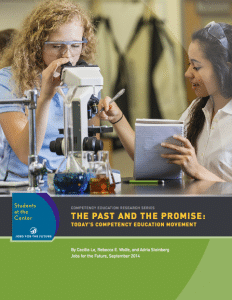The Past and the Promise
CompetencyWorks Blog
 Jobs for the Future released today The Past and the Promise: Today’s Competency Education Movement by Cecilia Le, Rebecca Wolfe and Adria Steinberg. There are two reasons for you to take the time to read this report:
Jobs for the Future released today The Past and the Promise: Today’s Competency Education Movement by Cecilia Le, Rebecca Wolfe and Adria Steinberg. There are two reasons for you to take the time to read this report:
1) To reflect on how the understanding of competency education is changing; and
2) To understand the research base that contributes to our understanding of competency education.
Defining Competency Education
The paper proposes that older versions of competency had three elements (mastery, pacing and instruction) and advances the idea that the models we are seeing in today’s enhanced version is a personalized competency education model with an additional six elements (competencies, assessment, flexible time, student agency, technology for instruction and monitoring learning, and cultures based on motivating and engaging students).
I also would add that previous models have been all classroom-based. However, here at CompetencyWorks, we are now operating on the assumption that competency education at a minimum requires whole school approaches. Stand-alone classroom doesn’t work for the following reasonis: 1) It’s impossible for a teacher to provide all the supports a student needs in the classroom and you can’t depend on after school or lunchtime as a reliable way for students to get extra help; 2) Once we know where students are on their learning progression it often makes sense for teachers (often working collaboratively) to group and regroup students so they get the help they need; and, 3) Ssome students that are “not yet proficient” may need additional time in terms of summer school or continuing on their learning progression in the next semester. One teacher in a classroom can’t mobilize that type of resource or coherency without a school wide approach.
The authors’ effort to differentiate between a competency-based model and a personalized competency-based approach really helps us think about what we want to be implementing in schools. Competency education is inherently personalized, in that students have different amounts of instructional support, time and effort in order to reach proficiency. This often is captured in the phrase “Time is the variable and learning is the constant.” However, this phrase is often reduced to self-paced rather than understanding time to be a proxy for three different resources – time, instructional support, and motivation/engagement/perseverance of students to keep working.
However, there are many other ways to personalize education, including 1) choice, 2) responding to interests, and 3) where and when students learn. Competency education enables this level of personalization with the infrastructure of transparent learning objectives and rubrics that define proficiency. A fourth type of personalization isn’t enabled by competency education but can be incredibly powerful to help students advance: Adaptive software programs continue to strengthen their capacity to respond to students and recognize ways to strengthen their learning. The feedback is faster than any teacher could ever provide, which means the students can get more practice.
As I thought about the nine elements of personalized competency education, I realized that they will still have different implications based on whether 1) you start with the premise that the job of schools doesn’t end until students have adequate proficiency to take on the next level (unit, course, grade or school), or 2) whether shadows of the bell-curve still lurk suggesting some students are going to learn the materials and others not so much. I tend to think of competency education as repurposing (and re-engineering) schools to produce learning rather than the delivery of instruction. In order for us to really be able to define what competency education is, we have to start with the core functions of schools.
The Research Behind Competency Education
I have to give a shout-out to the authors for their timeline “From Standardization to Competency Education,” which identifies the different educational movements from late 1800s to 2014. It is an incredibly helpful way to understand how we got to where we are today.
Their summary of the strands of research that are the foundation of competency education is invaluable. You will find the summaries of cognitive sciences, motivation theory, social aspects of learning, and assessment to be invaluable in reflecting on how your school is embedding these evidence-based practices.
I wish they had included child and adolescent development, with attention to gender and racial development. Competency education isn’t just about academic development; it’s about the habits or lifelong learning competencies, as well. It’s about learning the skills to be successful in college and careers. For some students this is learning how to defy stereotypes, manage anger and fear in the face of sexism and racism, and have the skills to confront bias and “isms” in academic settings.
Thanks to the authors for a major contribution the literature on competency education.